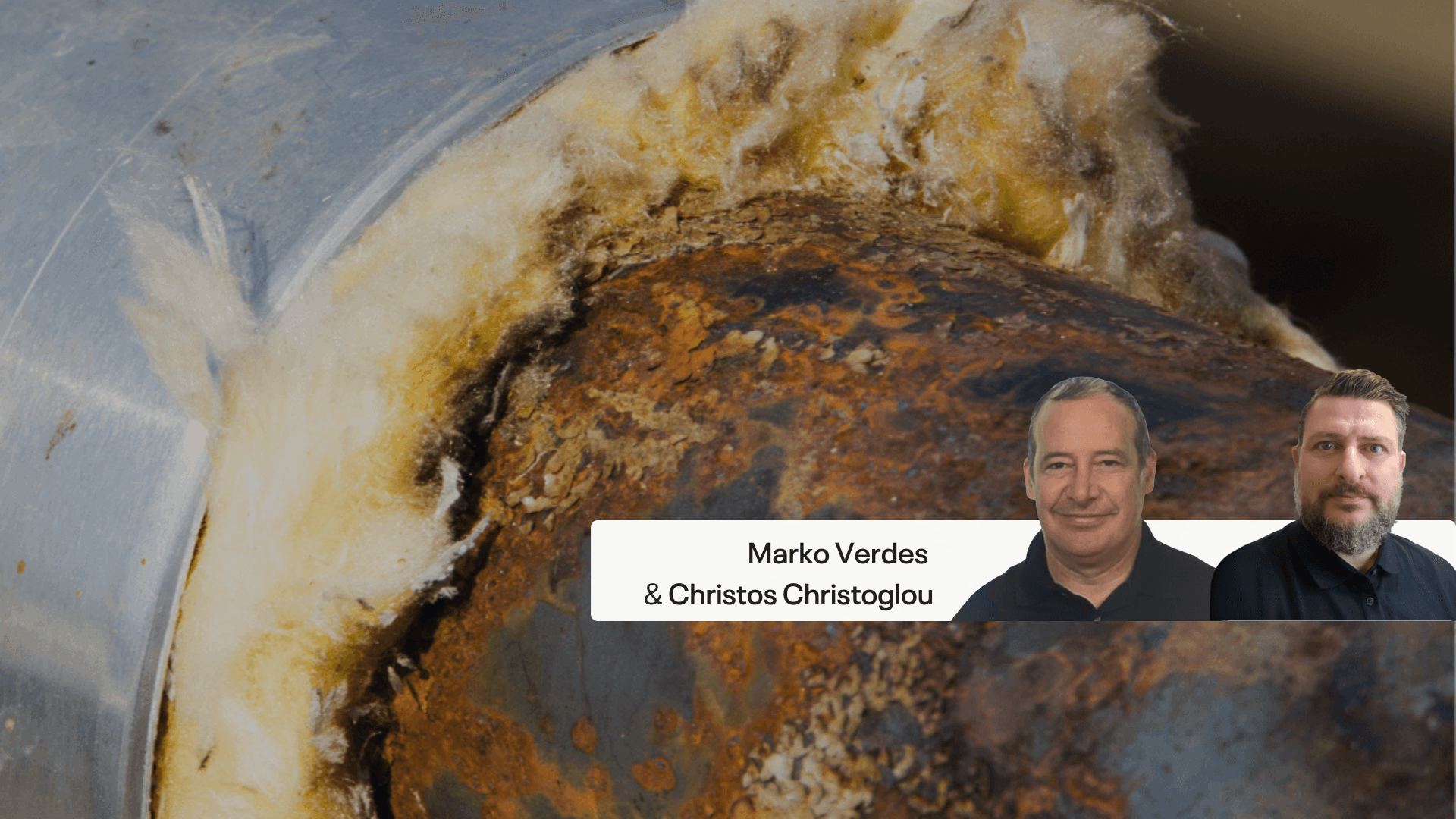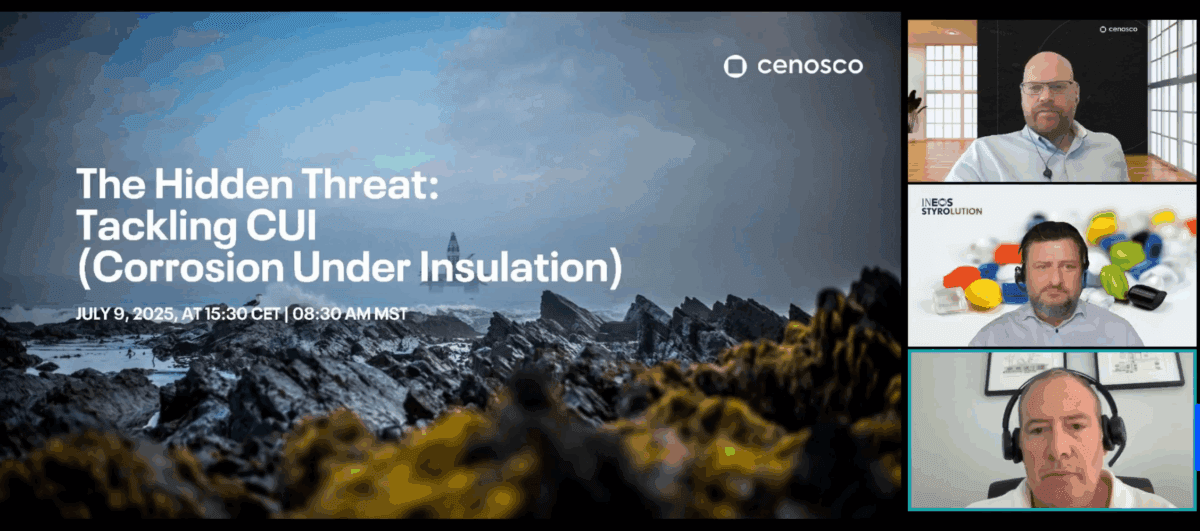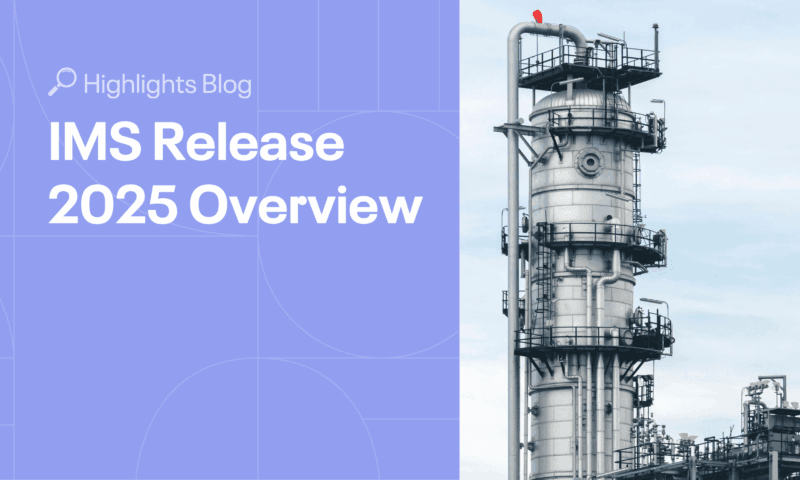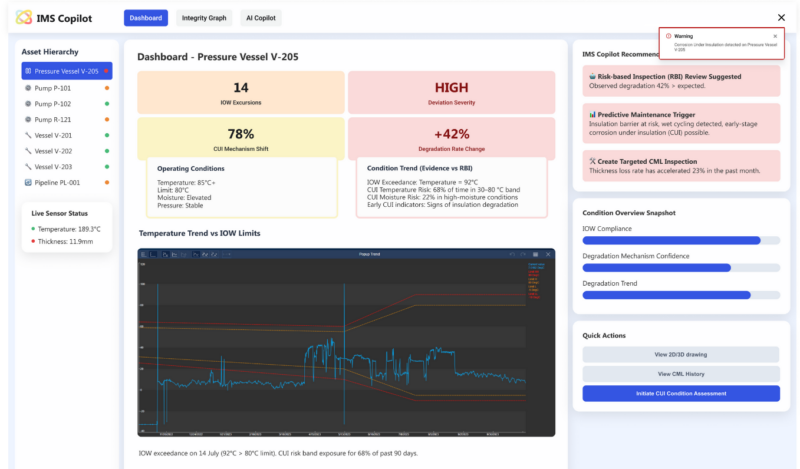Corrosion Under Insulation (CUI) continues to be one of the most complex, misunderstood, and costly forms of asset degradation in the process industries. It lurks beneath the surface, evades detection, and often strikes where you least expect it.
In our latest asset integrity webinar, over 200 professionals from 36+ companies tuned in to hear two leading experts, Christos Christoglou and Marko Verdes, unpack decades of hands-on experience in managing CUI—from design to detection, and from cost control to future-proofing strategies.
If you missed it, here’s your chance to catch up. We’re diving deep into the top insights shared, challenges raised, and what it really takes to build a smart, scalable, and sustainable CUI program.
Understanding CUI: It’s More Than Just a Maintenance Issue
One of the first myths busted in the webinar was the idea that CUI can be addressed with a simple inspection routine.
“CUI is not a task. It’s a program, a multidisciplinary, ongoing strategy that cuts across engineering, maintenance, production, process, and integrity.” – Marko Verdes
Because CUI occurs under insulation, it is often only detected once significant damage has occurred. Even modern sensor technology cannot always reveal corrosion that has been progressing undetected for 10 to 20 years. The key is to approach it not as a reactive process but as a strategic, ongoing initiative that adapts with the facility and its operating environment.
Why is CUI such a tough opponent?
- It’s hidden: The damage happens underneath insulation and isn’t visible until you remove it, or worse, until a leak forces your hand.
- It’s expensive: With thousands of insulated assets, the cost of inspection and repair can quickly skyrocket.
- It’s underreported: Many CUI-related incidents aren’t documented, meaning actual damage costs far exceed reported estimates.
What the Industry Is Still Struggling With
We polled participants ahead of the session, and the results were clear:
1. Detection & Identification (40%)
The biggest hurdle remains simply knowing where CUI is happening. Despite advancements, visual inspection still dominates, with X-ray and pulsed eddy current (PEC) as the next most common methods.
2. Implementation Complexity (18%)
Many companies struggle to launch a comprehensive program. Why? Because it requires cross-functional collaboration and long-term alignment, not just a line item in a budget.
3. Access and Insulation Removal (13%)
CUI work often involves scaffolding, encapsulation, or rope access. And insulation removal isn’t just time-consuming, it can be dangerous if legacy materials like asbestos are involved.
4. Cost Constraints (9%)
Budget alone doesn’t define program quality. In fact, one example highlighted a $1 million column inspection that revealed nothing, simply because the column had already been refurbished 6 years earlier.
5. Intermittent Conditions (8%)
Systems that cycle between hot and cold or shut down seasonally create hidden corrosion risks, especially in areas like dead legs or low-flow branches.
Building a CUI Program That Works in the Real World
Marko and Christos emphasized that no two CUI programs are identical. Geography, plant age, insulation types, and process conditions all play a role. However, there are foundational elements that all successful programs share:
➡️ Build the Right Team
A good CUI program starts with interdisciplinary alignment. Integrity engineers cannot, and should not, be the only stakeholders. Operations must be involved in granting permits, coordinating temporary installations, and supporting shutdown planning. Safety teams are critical, especially when dealing with legacy materials like asbestos or lead paint. Contractors must be vetted and monitored. Without strong collaboration, even the most well-funded programs fail.
➡️ Define Your Scope & Inventory
Shockingly, many sites don’t have a complete inventory of insulated assets. Christos noted that understanding the full scope of what is insulated, where it is, and why, is the foundation for prioritization. Without this visibility, efforts become scattered, reactive, and inefficient.
➡️ Prioritize with Purpose
Whether it’s 3,000 or 30,000 assets, you need a system to rank them. Focus first on high-consequence equipment: leaks that could impact people, the environment, or your bottom line.
➡️ Create Competition
Hiring multiple contractors for the same scope can improve performance. In one case, scaffold and insulation contractors competed to win more work, without compromising safety.
➡️ Capture & Use Your Data
Document everything: pre-inspection visuals, corrosion maps, coating conditions. Feed this into your asset integrity management system (AIMS), not just spreadsheets. This enables future planning and learning.
Technology Isn’t the Only Answer, But It Helps
There’s no silver bullet for CUI, but technology plays an important role. The top three NDT methods used by surveyed companies were:
- Visual Inspection – Still the most widespread due to ease of deployment and cost.
- X-ray Techniques – Effective, but limited by cost, safety protocols, and geometry.
- Pulsed Eddy Current (PEC) – Particularly useful for screening large areas without removing insulation.
Emerging technologies, such as humidity or corrosion sensors applied outside the cladding, show promise. Some can track water ingress in real time, showing how moisture travels along piping systems after rainfall.
However, as Marko pointed out: “Sensors show you the present. They don’t show the damage from the last 15 years. You still need to open up and see what’s going on underneath.”
Using sensors as an early warning system is smart, but they should complement, not replace, physical inspection and historical analysis.
Insulation & Coatings: The First Line of Defense
Preventing CUI starts at the design phase. Unfortunately, many projects don’t optimize for longevity; they optimize for upfront cost. Cheap insulation may hold moisture, while poor cladding systems allow ingress during storms. That combination of poor cladding, insulation, and moisture create the perfect environment for corrosion.
Modern materials like aerogel offer better hydrophobic performance and thermal insulation with less bulk. But as Marko and Christos emphasized, context matters. What works in dry Texas may fail in a cold, rainy northern environment. That’s why every insulation decision should be based on local conditions, risk profile, and long-term strategy.
Additionally, programs should reassess whether insulation is needed at all. In one project, 5% of lines were stripped and left uninsulated, protected instead with thermal coatings or cages for personnel protection.
The result: fewer corrosion risks and lower lifecycle costs.
Prioritization + RBI = Efficiency
Perhaps the most important takeaway from the session is this: a smart CUI program is about managing risk, not checking boxes. Programs that fail to align risk with inspection strategy often drown in false alarms.
Tips from the experts:
- Be realistic. Don’t let conservative guesses turn everything into “high risk.”
- Collaborate with operations. Understand what happens if a pipe leaks for 10 minutes.
- Don’t let your RBI model stagnate. Evolve it as new findings and technologies emerge.
Ultimately, CUI programs should reduce risk in a measurable, reportable way. And that only happens when the approach is grounded in field data, realistic scenarios, and active communication across departments.
There are no Shortcuts
“Everyone wants to skip to the solution – just tell me where to look. But CUI doesn’t work that way. There are no shortcuts, only smart programs.” – Marko Verdes
To tackle CUI properly, companies need to shift their mindsets: from reactive to proactive, from standalone inspections to full programs, from fragmented records to unified systems.
To future-proof your CUI strategy, you need:
- A cross-functional team;
- A risk-based methodology;
- Smart use of modern technology;
- Evolving program design; and,
- Institutional knowledge capture (preferably in an integrated AIMS).
Want to Improve Your CUI Strategy?
Ask yourself:
- Do we really know what’s under our insulation?
- Are we prioritizing based on consequence and likelihood?
- Is our data centralized and actionable?
- Are we evolving, or just repeating old patterns?
If any of those questions gave you pause – this is the moment to revisit your CUI program.
准备好演示了吗?
您准备好观看 IMS 套件的实际操作了吗?请填写下表预约演示!





